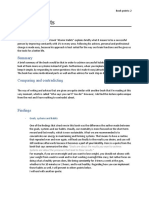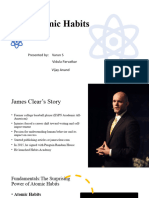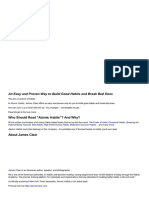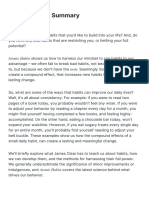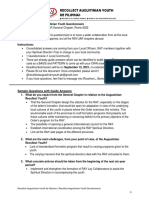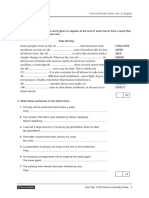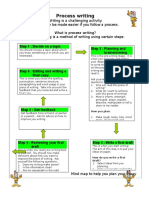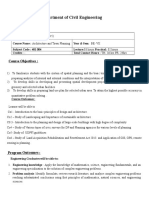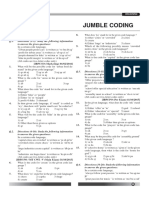Atomic Habits — Complete Summary (Inspired by James Clear’s Style)
Introduction: The Surprising Power of Atomic Habits
The book starts with a story about James Clear’s own life. A serious baseball injury in high school left
him in a coma. After a long recovery, he returned to sports, eventually becoming a top player and
excelling academically. His success wasn’t overnight — it came from small improvements made
consistently. That’s the idea behind atomic habits — tiny changes that compound over time.
Clear argues that success doesn’t come from huge leaps but from small improvements — just 1% better
every day. Over time, these tiny gains grow into remarkable results. The reverse is also true: small bad
habits, when repeated, lead to problems.
Chapter 1: The Fundamentals – Why Tiny Changes Make a Big Difference
Habits are the compound interest of self-improvement. Just like money multiplies through compound
interest, the effects of your habits multiply as you repeat them.
Clear emphasizes the importance of systems over goals. Goals are the results you want; systems are
the processes that lead to those results. Focusing on systems allows you to keep improving — even
after achieving a goal.
A key insight: habits shape your identity, and identity shapes your habits. Instead of saying “I want to
run a marathon,” say “I’m becoming a runner.” Every action is a vote for the type of person you want to
become.
Chapter 2: How Your Habits Shape Your Identity (and Vice Versa)
Clear explains the concept of identity-based habits. There are three layers of behavior change:
1. Outcomes (results)
2. Processes (systems and routines)
3. Identity (beliefs and worldview)
Most people focus on outcomes, but true change happens when you shift your identity. The goal is not
to read a book but to become a reader. Not to run once, but to become a runner.
Identity change comes from repeated action. If you write every day, you start seeing yourself as a writer.
This creates a feedback loop: identity drives behavior, and behavior reinforces identity.
Chapter 3: How to Build Better Habits in 4 Simple Steps
Clear introduces the habit loop — four stages of habit formation:
1. Cue – triggers your brain to initiate a behavior.
1
� 2. Craving – the motivational force.
3. Response – the action you take.
4. Reward – the benefit you gain.
Every habit follows this loop. For example: - Cue: You feel stressed. - Craving: You want relief. -
Response: You eat junk food. - Reward: You feel comforted.
To build better habits, make good behaviors obvious, attractive, easy, and satisfying — the four laws of
behavior change.
Chapter 4: The First Law – Make It Obvious
We often don’t notice our habits because they’re automatic. Clear recommends a strategy called habit
stacking — linking a new habit to an existing one. Example: “After I brush my teeth, I’ll meditate for one
minute.”
Also, the environment plays a key role. If you want to read more, leave books visible. Want to snack
less? Hide the junk food. Don’t rely on motivation; design your environment.
Chapter 5: The Second Law – Make It Attractive
We repeat habits that are attractive. Clear introduces the concept of temptation bundling: pair an
action you want to do with one you need to do. For example: “I’ll watch Netflix only while I’m on the
treadmill.”
Social environments also shape habits. We tend to imitate the habits of: - The close (friends, family) -
The many (our tribe) - The powerful (those we admire)
By surrounding yourself with people who embody your desired habits, you make them more attractive.
Chapter 6: The Third Law – Make It Easy
Repetition builds habits — not perfection. Clear emphasizes that the number of times you do a habit
matters more than how long you do it.
He introduces the Two-Minute Rule: Make your habit so simple that it takes less than two minutes. For
example: - Read one page - Put on workout clothes - Write one sentence
These small starts overcome resistance and make habits easier to maintain. Master the art of showing
up.
Chapter 7: The Fourth Law – Make It Satisfying
What’s immediately rewarded gets repeated. What’s immediately punished gets avoided. Since many
good habits offer delayed rewards, Clear suggests using reinforcement techniques like habit tracking
and accountability.
2
�A habit tracker (e.g., crossing off days on a calendar) provides visual proof of progress and motivates
you not to break the chain.
Also, Clear stresses: Never miss twice. Missing once is okay; missing twice is the start of a new (bad)
habit.
Chapter 8: How to Break a Bad Habit
To break a bad habit, reverse the four laws: 1. Make it invisible – Remove cues. 2. Make it
unattractive – Reframe your mindset. 3. Make it difficult – Add friction. 4. Make it unsatisfying – Use
accountability.
Example: If you want to stop checking your phone at night: - Leave it in another room (invisible) -
Remind yourself how it affects sleep (unattractive) - Use an app blocker (difficult) - Ask a friend to check
in (unsatisfying to fail)
Breaking habits requires conscious effort to interrupt the loop.
Chapter 9: The Role of Family and Friends in Shaping Your Habits
We adopt habits from those around us. If your family or peer group values fitness, you’re more likely to
be fit. Clear highlights how social norms and approval drive behavior.
Want to change? Join a group where your desired behavior is normal. Being accepted by the tribe often
matters more than individual desires. Social belonging helps reinforce identity.
Chapter 10: How to Find and Fix the Causes of Your Bad Habits
Every behavior has a purpose — it solves a problem. Bad habits often fulfill a need (comfort, escape,
stimulation) in a harmful way. To fix them, understand the cause.
Instead of attacking the symptom (e.g., procrastination), address the root (e.g., fear of failure).
Awareness is key. Ask yourself: - What need does this habit fulfill? - Can I meet that need in a healthier
way?
Chapter 11: Walk Slowly, But Never Backward
The focus should be on consistency over perfection. Clear shares the story of a photography class:
one group graded on quantity (taking many photos), the other on quality. The quantity group improved
the most — through practice, not planning.
Lesson: Don't wait to be perfect. Start, repeat, refine. Success is built on volume.
3
�Chapter 12: The Law of Least Effort
Humans naturally choose the path of least resistance. Design your environment so the easy choice is
the good one.
• Want to eat healthy? Prepare meals in advance.
• Want to read more? Keep a book near your bed.
Habits grow where friction is low. Automate and simplify good behaviors.
Chapter 13: How to Stop Procrastinating by Using the Two-Minute Rule
Clear reemphasizes the Two-Minute Rule: “When you start a new habit, it should take less than two
minutes to do.”
This helps overcome procrastination. It’s easier to start small and build momentum. Once you begin,
you’re likely to keep going.
Examples: - Fold one pair of socks - Write one sentence - Meditate for 60 seconds
Starting is the hardest part. Master it.
Chapter 14: How to Make Good Habits Inevitable and Bad Habits Impossible
Create a commitment device — a choice you make in the present to lock in better behavior for the
future.
Examples: - Automatic savings deductions - Pre-paid gym classes - Unplugging your TV after a set time
Also, increase friction for bad habits: - Delete social apps - Block distracting websites
Make good habits automatic; make bad habits inconvenient.
Chapter 15: The Cardinal Rule of Behavior Change
What is immediately rewarded is repeated. Clear stresses the need for immediate satisfaction to
reinforce good habits.
Even small rewards (checking off a habit tracker) help build consistency. Over time, the real reward
becomes identity change: seeing yourself as disciplined, reliable, strong.
Delayed gratification (like fitness or saving money) becomes easier when your identity supports it.
4
�Chapter 16: How to Stick with Good Habits Every Day
Use habit tracking — visually marking your progress keeps motivation high. Seeing your streak builds
momentum.
Don’t break the chain. And if you do — never miss twice. A bad day is okay. Two in a row risks forming
a new habit.
Clear also mentions accountability — having someone check your progress boosts commitment.
Chapter 17: How an Accountability Partner Can Change Everything
An accountability partner raises the cost of bad habits. If someone is watching, you’re more likely to
follow through.
For example: - Tell a friend your goal - Sign a habit contract (e.g., pay money if you fail)
Social pressure, when used wisely, keeps you on track.
Chapter 18: The Truth About Talent (When Genes Matter and When They Don’t)
Clear acknowledges the role of genetics. Some people have natural strengths, but you should focus on
choosing the right field — one that aligns with your talents.
Play to your strengths. You’re more likely to stick with habits that feel natural. Success is easier when
you're doing what suits you.
Chapter 19: The Goldilocks Rule – How to Stay Motivated in Life and Work
The Goldilocks Rule: Humans experience peak motivation when working on a task that’s not too hard,
not too easy — just right.
To stay motivated: - Add a little challenge - Track progress - Avoid boredom by varying your routine
Clear reminds us: mastery requires repetition and interest.
Chapter 20: The Downside of Creating Good Habits
Habits create freedom, but can also create mindlessness. Once something becomes automatic, you
stop thinking about it. This can lead to plateauing.
The solution is reflection and review. Regularly assess your habits: - Are they still serving you? - Can
they be improved?
Always aim for growth.
5
�Conclusion: The Secret to Results That Last
True behavior change is identity change. The goal isn’t to run a marathon — it’s to become a runner. Not
to write a book — but to become a writer.
Focus on small improvements. Let them compound. Build systems, not goals. Shape your environment.
And remember:
“You do not rise to the level of your goals. You fall to the level of your systems.”
Start small. Stay consistent. Become the type of person you want to be.
This is the power of Atomic Habits.














